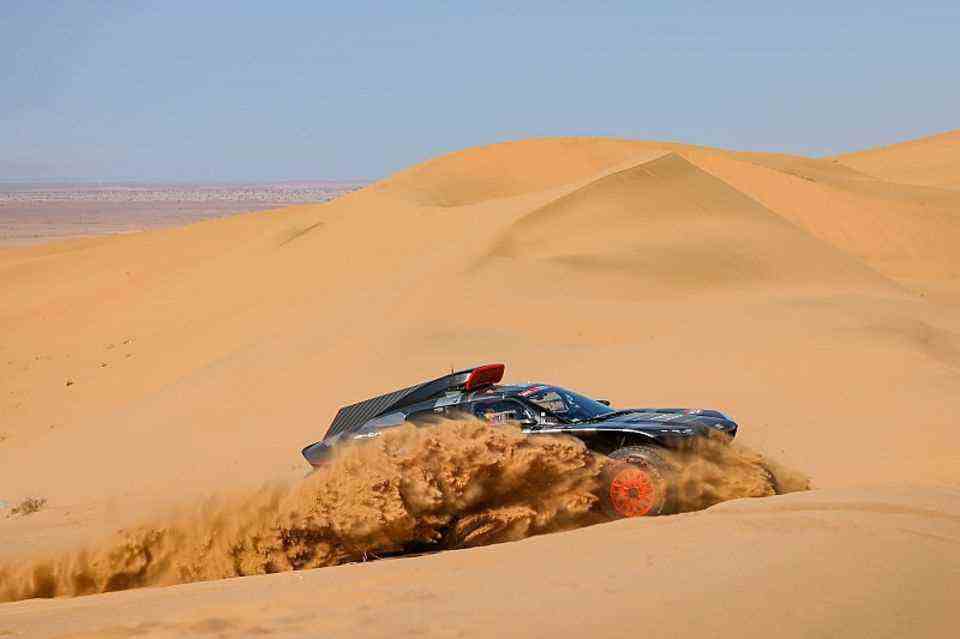Dakar Rally 2022
Hot ride through the desert
Carlos Sainz
© press-inform – the press office
At the Dakar Rally, more than 500 drivers fight their way through the Arabian desert over 8,119 kilometers in scorching heat. The effort is immense, but failure at the Dakar is still on the agenda.
Compared to the Dakar Rally, the WRC World Rally Championship is like a hundred meter sprint on a tartan track to a cross-country marathon, in which you go over hill and dale in unfamiliar terrain. The tough guys are on the road at the Dakar. It starts with the escort, in which the drivers in heavy trucks shoot from stage destination to stage destination regardless of losses. After all, they have to arrive with the racing cars because only then can the service begin. “It’s really tough,” says Juri, a Russian mechanic who was already at the Paris-Dakar rally. After all, the support vehicles do not have high-tech chassis like the buggies “Some of them are a few centimeters smaller at the finish than at the start”; laughs the mechanic.
The range of vehicles extends from self-made, better golf karts, with which most of them don’t dare to go on the road, let alone into the desert with huge dunes, to buggies and motorbikes on which saddle artists thunder through the desert at hell’s speed with their heads and necks take risk. Every fall can be the last. The top of the high-speed caravan is made up of well-bred racing cars such as the Audi RS Q e-tron, the Toyota GR DKR Hilux T1 + and the BRX Hunter, which are racing across the sand in the T + class. The futuristic-looking Audi is the most photographed vehicle at this year’s Dakar. The top cars fire over sand and stone with around 294 kW / 400 PS.
For the Dakar purists, the wild desert hunt is just a tired copy of the original long-distance rally, which at that time was still called Paris-Dakar and in which at least one participant has joined the heavenly host every year. But the competition is being carried out with full commitment. Decide little things and every mistake can cost a lot of time. The Dakar is now a full-throttle sprint regardless of losses. The only difference is that it is not a circuit race on asphalt, but rather a balancing act on coarse-tread tires. A material battle rages between Jeddah and Riyadh for 14 days (including the prologue and a day of rest) that is unparalleled and that pushes man and machine to the limits of their capacity. Every tenth is bitterly fought. It starts right at the start, where some drivers line up a few meters from the line to fly through the beginning of the time measurement. But one thing is clear to everyone: At the Dakar, failure is still the order of the day.
A lot is at stake for the top teams. Putting a competitive car on its wheels devours several million euros. So the best drivers are just good enough. Racing stars such as nine-time world rally champion Sébastien Loeb (BRX), two-time world rally champion and three-time Dakar winner Carlos Sainz, two-time DTM winner Mattias Ekström and 14-time Dakar triumphant Stéphane Peterhansel (six times with the Motorcycle, eight times in the four-wheel racing cars). The best is only good enough. Accordingly, the Dakar company is being prepared in a thorough manner and the cars are trimmed for reliability and speed in extensive tests down to the last screw. The classic conflict of goals in racing, except that here it goes over 8,119 kilometers in scorching heat, 4,261 kilometers of which are included in the rating.
Ideally, three participants per team start. Then there are those race trucks that chase after the field with a monkey tooth, because in the event of a defect, the participants are on their own. The regular supply vehicles with the mechanics are only allowed to repair the cars at certain points. A golden rule is: do not put small parts in the sand, as they will almost certainly disappear. However, teammates can help each other. That is precisely why every team capable of winning has a race truck that is part of the competition. However, regardless of the speed at which the heavy trucks rush through the dunes, it takes a long time to arrive at the breakdown site. When it comes to victory, valuable time is wasted. That’s why the slowest of the three team-mates who are on the road in the super-fast bolides becomes a luxury helper and his car is filled with spare parts. Like a water carrier in the Tour de France, he has to stand by his team captain when the need arises.
There used to be the road books the day before, which the co-pilot used to search for the right path. Teams like VW hired specialists who prepared the information overnight so that the teams could find their way around without major problems. In the meantime, the rules of the game have changed: the road book is only given 15 minutes before the start. It is the task of the teams to hit the waypoints, otherwise there is a risk of penalty points. Last year this scavenger hunt caused confusion, stray vehicles and fights for some teams. No wonder, the stress factor is great. Accurately hitting a waypoint in a desert is not easy. One mistake has a whole domino effect. Getting lost once can cost a lot of time and thus victory. In addition, nobody knows what is lurking behind the next dune. The stress factor is immensely high. Then your fists sit loosely.


